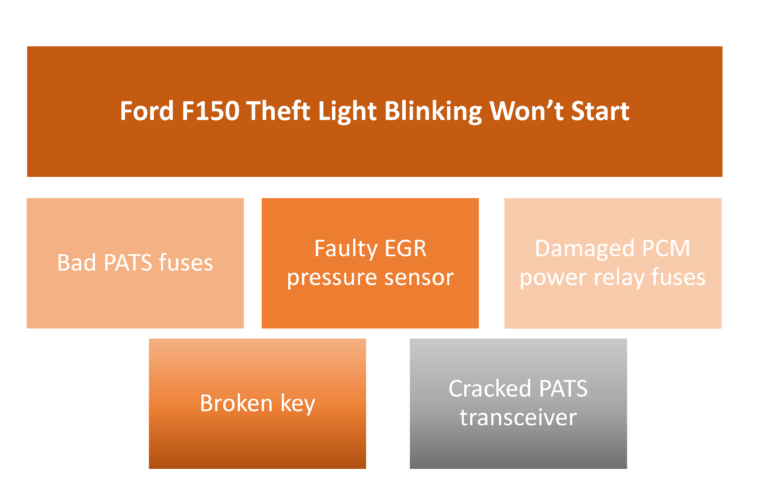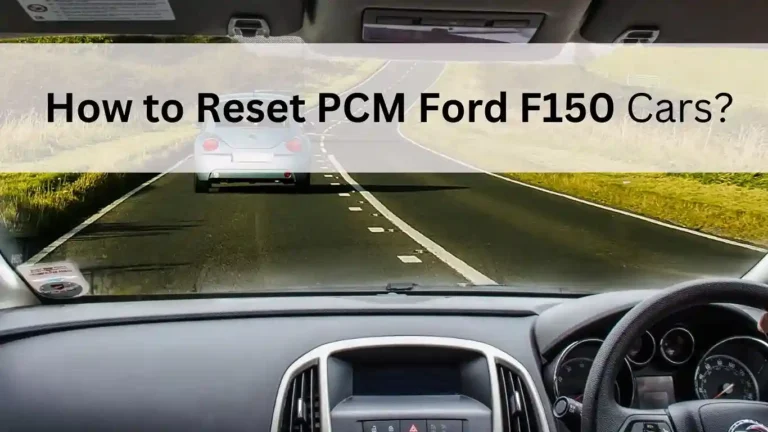Because of faulty PATS or PCM fuses, your Ford F150 Theft light blinking and not starting. Apart from this, it can happen due to a faulty EGR pressure sensor, key, or PATS transceiver. You can repair it by changing the fuses or bad parts.
Don’t panic if your car is constantly flashing Theft lamp and won’t start! Here, I’ll break down the exact reason why your car’s Theft lamp flashes and won’t start before sharing the solutions.
Let’s Get into It!
Table of Contents
Why Ford F150 Theft Light Blinking Won’t Start
Several aspects can cause your new or old (2000 – 2018) Ford F150 Theft light blinking won’t start issue. Let me explain a few of these reasons and how to fix them below:
| Causes | Repairs |
| Bad PATS fuses | Change the PATS fuse |
| Faulty EGR pressure sensor | Replace the EGR pressure sensor |
| Damaged PCM power relay fuses | Remove and install new PCM power relay fuses |
| Broken key | Change it with a new programmed key |
| Cracked PATS transceiver | Replace the PATS transceiver |
1. Damaged PATS Fuses
If your 1993 – 2013 Ford F150 Theft light blinking won’t start, it occurs because of bad PATS (Passive Anti Theft System) fuses.
When the PATS fuses burn due to electrical interference, it can cause the Theft lamp to flash and your car won’t start. To resolve it, you’ll need to change the burnt fuses.
How to Fix?
You’ll need to open the front hood of your F150 car and find the engine compartment fuse box. Then, open the lid of the engine compartment fuse box.
After that, locate the PATS fuses based on the owner’s manual. Next, check for burnt marks in the fuses and then replace them with new ones. Then, reattach the lid on the fuse box and close the hood.
Repair Cost: $100 or above ($5 – $10 for parts and the rest for labor).
Duration: 5 – 10 minutes.
2. Bad EGR Pressure Sensor
When the EGR pressure sensor fails to operate, the old or new 2016 Ford F150 Theft light starts to blink and won’t start. The best way to detect this is by pulling out the EGR pressure sensor connectors.
Then, you’ll see the odometer show dashes and theft light flashes causing your F150 not to start. You’ll need to replace the EGR pressure sensor to resolve the issue.
How to Fix?
To begin with, you’ll need to open the hood and then locate the EGR pressure sensor connector location. It is usually underneath a big cover that hides the whole part.
You’ll need to use an 8mm socket to remove the 3 bolts that hold the cover and then detach the cover. Next, take out the vacuum hoses and ensure to mark them or take a picture if you can’t remember which one goes where.
Afterward, detach the 2 nuts using the 8mm socket and take out the EGR pressure sensor (black part). Next, put on the new EGR pressure sensor and reinsert the vacuum hoses. Then, reattach all the removed parts.
Repair Cost: $150 – $200 or above ($50 for parts and the rest for labor).
Duration: 40 minutes.
3. Faulty PCM Power Relay Fuses
Mostly, the F150 Ford Theft code 15 or 11 while the light flashes to indicate the issue of the PCM power relay in the fuse box. It happens as no power is going to the PCM unit causing the Theft light to flash. To repair it, you’ll need to change the PCM-related fuses.
You don’t want to neglect the PCM unit as once it’s completely off, the f150 will start showing more issues. One of the more common problems is intermittent starting with the f150. You may also find the f150 failing to start with no clicking noise.
How to Fix?
Inside the hood, open the lid of the fuse box. After that, locate the PCM-related fuses and then check the condition.
If one or more fuses contain brown or black marks or melt out, immediately replace them with new ones. Then, reinstall the lid on the fuse box and close the hood.
Repair Cost: $150 – $200 or above ($50 – $100 or more for parts and the rest for labor).
Duration: 10 minutes.
4. Damaged Key
The old or new 2017 Ford F150 Theft light blinking but won’t start issue can occur when the key itself is faulty. You can easily detect it by seeing the theft lamp for the error code. To fix this, you’ll need to change the old key and use a new traditional or smart key which is programmed.
How to Fix?
Once you get the F150 Ford Theft code 13 or 15, it means the key is faulty and requires replacement.
To change it, you’ll need to contact the Ford and get your new key programmed. If you have a second key, then use that for your instant driving purpose. On a different note, you may find some methods discussed in this guide helpful, which are primarily for unlocking a f150 with a key locked inside.
Repair Cost: $40 – $250 or above (for part and programming).
Duration: 5 minutes.
5. Broken PATS Transceiver
Sometimes the PATS can fail to detect the key that you put inside the keyhole. Due to this, your new or old 2012 Ford F150 Theft light blinking won’t start. You can easily resolve it by changing the PATS transceiver.
A Ford F150 Forum user shared that such a situation can also be resolved by using a specialized tool like FORScan to read the codes from the PATS system.
This will provide specific information about why the theft light is flashing, whether it’s related to the key chip, the transceiver, or another issue, enabling a more targeted resolution. This suggestion makes sense and I recommend it if you have the resource for trying this out.
How to Fix?
To start with, get inside the car and use a screw gun to take out the bolts that hold the bottom plastic trim panel (in the steering column).
Then, use a pry bar to take out the steering column’s bottom plastic trim panel. Now, you can physically hold the PATS transceiver from the ignition keyhole.
If needed, use the same pry bar to remove the bottom plastic trim panels that help to track the wiring part of the PATS transceiver.
Next, unplug the PATS transceiver plug from the car and check its condition. If it looks okay, put it back on properly or replace it with a new one. Then, reinstall all the removed parts.
Repair Cost: $400 or above ($50 – $150 for parts and the rest for labor).
Duration: 30 minutes.
Wrap Up
If your Ford F150 Theft light blinking won’t start, it’s vital to figure out the reason before hopping into the fixes. You can easily do this by using a scan tool.
Sometimes, a simple Ford F150 anti-theft bypass or reset trick can resolve this type of issue.
I hope this guide helps you identify the cause of the issue and that you’ll give the suggested solutions a try. Good Luck with This Project!




